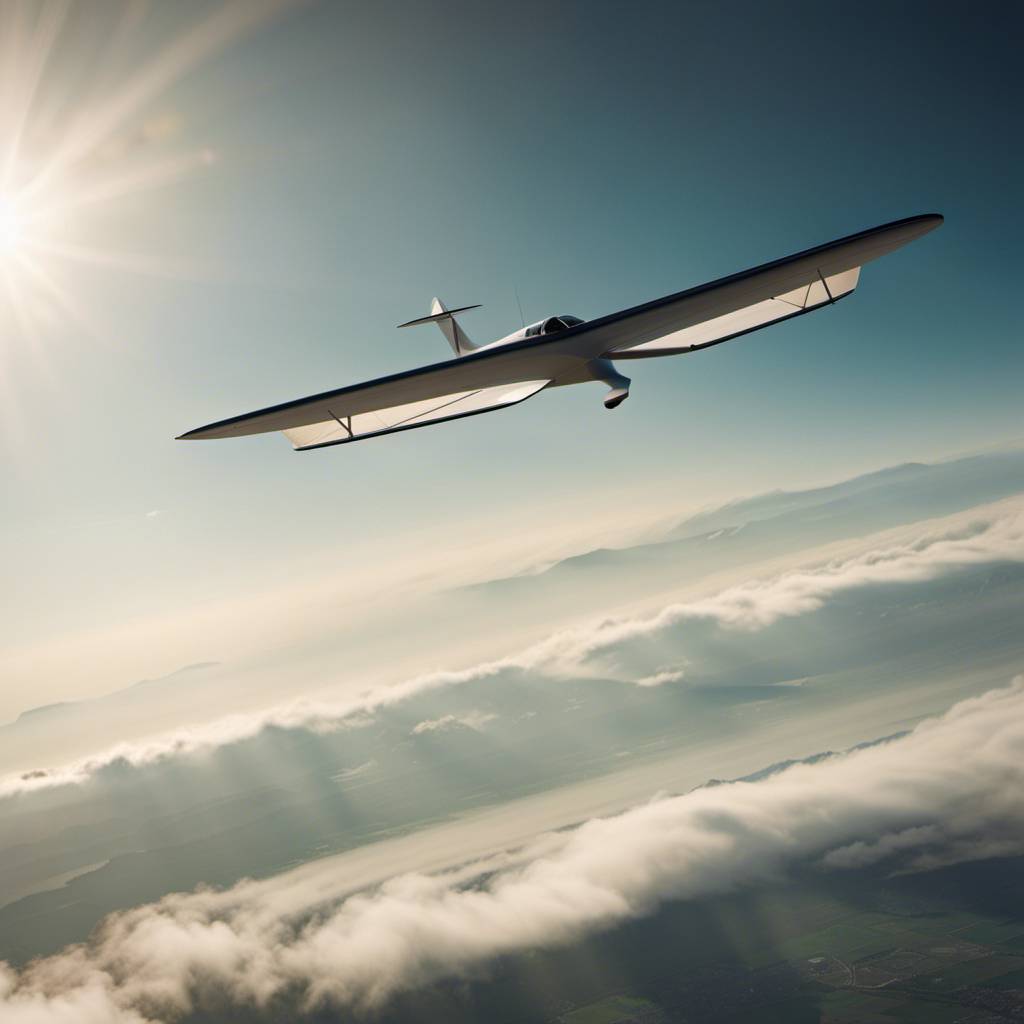When it comes to maximizing my sailplane’s performance, it’s crucial not to overlook the importance of the tail dimensions. Finding the perfect tail size is like finding the key to unlocking the full potential of my gliding adventures.
In this article, I’ll delve into the intricacies of tail size optimization, exploring the factors to consider, the effects on performance, and the recommendations for different sailplanes.
Get ready to take your sailplane to new heights as we uncover the secrets behind tail size selection.
Key Takeaways
- Tail size modifications and maintenance are important for aerodynamic stability, maneuverability, and overall performance of a sailplane.
- Avoid common mistakes such as assuming that a larger tail always provides better stability and not considering specific aerodynamic characteristics or weight distribution.
- Real-life examples and case studies have shown that tail size optimization can lead to improved stability, control, and performance in racing and cross-country flights.
- Factors to consider when determining the perfect tail size include stability, maneuverability, speed, flying style, and prevailing conditions for optimal performance.
Understanding the Role of the Tail in Sailplane Performance
To optimize the performance of your sailplane, you’ll need to understand the role of the tail. The tail of a sailplane plays a crucial role in its overall handling characteristics. The size of the tail is determined by various factors affecting tail size selection, and it has a significant impact on sailplane handling.
One of the key factors that affects the selection of tail size is the weight and balance of the sailplane. The tail must be designed in such a way that it provides the necessary stability and control, especially during maneuvers. If the tail is too small, the sailplane may become unstable and difficult to control. On the other hand, if the tail is too large, it may create excessive drag and reduce the overall performance of the sailplane.
Another factor to consider when determining the size of the tail is the desired maneuverability of the sailplane. A larger tail provides more control authority, allowing for precise and responsive handling. However, it also increases the drag, which can negatively impact the sailplane’s overall speed and efficiency. Conversely, a smaller tail reduces drag but may sacrifice some maneuverability.
Factors to Consider When Choosing the Size of Your Sailplane’s Tail
Consider the factors when deciding on the appropriate dimensions for your sailplane’s tail. Tail size optimization plays a crucial role in enhancing the performance of your sailplane.
To help you make an informed decision, here are some key factors to consider:
- Stability: A larger tail provides greater stability, making it easier to control the sailplane during flight.
- Maneuverability: A smaller tail allows for more agile and responsive maneuvers, ideal for aerobatic flying.
- Center of Gravity: The tail size should be balanced with the rest of the sailplane to maintain proper weight distribution.
- Wing Loading: The tail size should be proportional to the wing area and loading to ensure optimal flight characteristics.
- Wind Conditions: Tail size should be adjusted based on the typical wind conditions you fly in to maintain stability and control.
Taking these factors into account, you can determine the appropriate dimensions for your sailplane’s tail and optimize its performance.
Next, we will explore the effects of different tail sizes on sailplane performance, delving into how they impact various aspects of flight.
The Effects of Different Tail Sizes on Sailplane Performance
When choosing the dimensions of your sailplane’s tail, it’s important to understand how different sizes can impact its performance. Tail size plays a crucial role in the overall aerodynamics of the aircraft and can significantly affect its maneuverability. To fully grasp the effects of tail size on sailplane performance, it is necessary to delve into the realm of tail aerodynamics.
To illustrate the impact of tail size on maneuverability, let’s consider the following table:
| Tail Size | Maneuverability |
|---|---|
| Large | Decreased |
| Medium | Moderate |
| Small | Enhanced |
As the table reveals, a larger tail size tends to decrease maneuverability, while a smaller tail size enhances it. This is because a larger tail generates more drag, making the sailplane less responsive to control inputs. On the other hand, a smaller tail size reduces drag and allows for quicker and more precise maneuvering.
Understanding these fundamental principles of tail aerodynamics and the impact of tail size on maneuverability is crucial when determining the optimal size for your sailplane’s tail. In the subsequent section, we will explore tail size recommendations for different types of sailplanes, ensuring that you make an informed decision for your aircraft’s performance without missing a beat.
Tail Size Recommendations for Different Types of Sailplanes
For optimal performance, you’ll want to know the recommended tail sizes for different types of sailplanes.
When it comes to aerobatic sailplanes, a smaller tail size is typically recommended. This allows for increased maneuverability and responsiveness, which are essential for performing intricate aerobatic maneuvers.
On the other hand, high performance sailplanes benefit from a larger tail size. This helps to maintain stability at higher speeds and enhances the overall efficiency of the aircraft. The larger tail acts as a counterbalance to the main wing, allowing for better control and smoother flight.
It is important to note that these recommendations are general guidelines and may vary depending on the specific design and characteristics of each sailplane. Tail size modifications and adjustments for personalized performance can be made to fine-tune the handling and response of your sailplane.
Tail Size Modifications and Adjustments for Personalized Performance
By experimenting with different tail configurations, you can personalize the performance of your sailplane. Tail size adjustments and modifications can have a significant impact on the handling and stability of your aircraft. Whether you are looking to improve maneuverability or increase stability, understanding how tail size affects performance is crucial.
One way to analyze the effects of tail size modifications is by comparing the performance characteristics of different configurations. The table below provides a simplified overview of the potential changes that can occur with different tail sizes:
| Tail Size | Maneuverability | Stability | Control |
|---|---|---|---|
| Larger | Decreased | Increased | Enhanced |
| Smaller | Increased | Decreased | Reduced |
Increasing the size of the tail will generally decrease maneuverability but increase stability. This can be beneficial for pilots who prioritize stability over agility. On the other hand, reducing the tail size will enhance maneuverability but may compromise stability. This can be advantageous for pilots who prefer a more responsive and agile aircraft.
It is important to note that tail size modifications should be approached with caution. It is always recommended to consult with experts and experienced pilots for tail size recommendations. They can provide valuable insights based on their knowledge and expertise, ensuring that your sailplane’s performance is optimized for your specific needs.
Consultation with Experts and Experienced Pilots for Tail Size Recommendations
Consulting with experts and experienced pilots can provide you with valuable insights and recommendations on tail size modifications. When considering the size of the tail for your sailplane, it is crucial to understand the implications and trade-offs involved.
Here are a few key points to consider:
-
Aerodynamic Stability: An expert can help you determine the optimal tail size to ensure stability during flight, minimizing the risk of stalls or uncontrollable maneuvers.
-
Maneuverability: A smaller tail size can enhance maneuverability, allowing for quick and precise control inputs. However, this may come at the cost of stability, requiring more pilot skill and attention.
-
Performance: The tail size can have a direct impact on the overall performance of the sailplane. An appropriately sized tail can improve efficiency, reducing drag and enhancing glide performance.
By consulting with experts and experienced pilots, you can make informed decisions about tail size modifications that align with your specific needs and preferences. This knowledge will help you achieve optimal performance while maintaining the desired level of stability.
Moving forward, it is essential to recognize the importance of proper maintenance and inspection of sailplane tails to ensure continued safety and performance.
Importance of Proper Maintenance and Inspection of Sailplane Tails
Proper maintenance and inspection of sailplane tails is crucial for ensuring continued safety and performance. Regular inspection of the tail is of utmost importance to identify any potential risks and prevent them from escalating. Neglecting maintenance can lead to various problems, such as decreased control responsiveness, decreased stability, and even structural failure of the tail.
Regular inspection allows for the early detection of any signs of wear and tear, such as cracks, loose fittings, or damage to control surfaces. By addressing these issues promptly, we can prevent them from worsening and causing further damage. It is also essential to check for any signs of corrosion or deterioration, as these can compromise the structural integrity of the tail.
Neglecting maintenance not only puts the pilot and passengers at risk but can also lead to costly repairs or even the need for a complete replacement of the tail. Additionally, it can impact the overall performance of the sailplane, affecting its maneuverability and efficiency.
In the next section, we will discuss common mistakes to avoid when choosing the size of your sailplane’s tail, ensuring that it complements the overall design and performance of the aircraft.
Common Mistakes to Avoid When Choosing the Size of Your Sailplane’s Tail
When choosing the size of your sailplane’s tail, it’s important to avoid common mistakes that can impact its overall design and performance. One of the factors to avoid is the misconception that a larger tail will always result in better stability. While it is true that a larger tail can provide more stability, there is a point where increasing the size becomes counterproductive.
Another common misconception is that the tail size should be proportional to the wing size. While there is some correlation between the two, it is not a direct relationship. The tail size needs to be determined based on the specific aerodynamic characteristics of the sailplane, such as its center of gravity and desired maneuverability.
Additionally, it is important to consider the weight distribution of the sailplane when selecting the tail size. A tail that is too small can lead to an unstable flight, while a tail that is too large can increase drag and decrease performance. By avoiding these misconceptions and considering the specific factors mentioned, you can optimize the tail size of your sailplane for better overall design and performance.
Transitioning into the subsequent section about real-life examples and case studies of tail size optimization in sailplanes, it is interesting to analyze how different design choices have led to improved performance and handling characteristics in various sailplane models.
Real-Life Examples and Case Studies of Tail Size Optimization in Sailplanes
After discussing the common mistakes to avoid when choosing the size of your sailplane’s tail, it is now time to delve into real-life examples and case studies that demonstrate the importance of tail size optimization and its impact on sailplane performance.
Gathering data from various sailplane pilots and manufacturers, these examples provide valuable insights into how tail size can significantly affect the overall performance and handling characteristics of a sailplane.
One such case study involved adjusting the size of the tail in a high-performance sailplane. By carefully analyzing the flight data and making small modifications to the tail size, the pilot was able to achieve improved stability and control, resulting in better maneuverability during both thermaling and high-speed flight. This optimization process not only increased the sailplane’s overall performance but also enhanced the pilot’s confidence and enjoyment in flying.
In another real-life example, a manufacturer conducted extensive wind tunnel testing to determine the optimal tail size for a new sailplane design. By systematically varying the tail size and measuring the resulting aerodynamic forces, they were able to identify the perfect balance between stability and maneuverability. This tail size optimization significantly improved the sailplane’s performance, making it more competitive in both racing and cross-country flights.
By examining these real-life examples and case studies, we can gain a deeper understanding of the importance of tail size optimization and its impact on sailplane performance.
In the next section, we will draw conclusions from these findings and discuss how to find the perfect tail size for your sailplane.
Conclusion: Finding the Perfect Tail Size for Your Sailplane
To determine the ideal tail size for your sailplane, you should consider the insights gained from the real-life examples and case studies discussed previously. By analyzing these examples, we can make informed decisions to optimize sailplane performance based on tail size considerations for different flying conditions.
Here are three key points to keep in mind:
-
Tail size and stability: The size of the tail has a direct impact on the stability of the sailplane. A larger tail surface area provides greater stability, especially during maneuvers such as turns and loops. However, it may also increase drag, leading to reduced overall performance. Finding the right balance between stability and performance is crucial.
-
Tail size and maneuverability: Smaller tail sizes result in increased maneuverability, allowing for quick and responsive control inputs. This is particularly beneficial in dynamic flying conditions or aerobatics. Conversely, larger tail sizes sacrifice some maneuverability for improved stability during long-distance flights or in turbulent air.
-
Tail size and speed: Tail size affects the sailplane’s ability to maintain high speeds. A smaller tail surface area reduces drag and allows for higher speeds, making it suitable for competitions or soaring in flatland areas with less turbulent air. On the other hand, a larger tail provides more stability at high speeds, enhancing safety during high-speed dives or in gusty conditions.
Considering these factors, it is essential to assess your flying style, intended use, and the prevailing flying conditions to find the ideal tail size for optimal sailplane performance.
Frequently Asked Questions
Can I use the same tail size for all types of sailplanes?
Tail size considerations and recommendations vary depending on the type of sailplane. It is not recommended to use the same tail size for all sailplanes as different designs and flight characteristics require specific tail sizes for optimal performance.
How does the tail size affect the maneuverability of a sailplane?
Tail size impact on maneuverability is crucial. A larger tail enhances agility, allowing for quick and precise movements. Conversely, a smaller tail sacrifices maneuverability but offers stability. A careful analysis is required to strike the perfect balance.
Are there any safety considerations when choosing the size of a sailplane’s tail?
When choosing the size of a sailplane’s tail, safety considerations are crucial. The tail size impacts maneuverability, stability, and control. It is important to find the right balance to ensure a safe and efficient flight experience.
Can I make adjustments to the tail size of my sailplane on my own?
Yes, I can make custom adjustments to the tail size of my sailplane. However, it is important to consider the tail size limitations set by the manufacturer to ensure the aircraft’s stability and performance.
Are there any specific regulations or guidelines regarding the size of a sailplane’s tail?
There are specific regulations and guidelines that govern the size of a sailplane’s tail. These requirements ensure proper aerodynamic stability and control. Compliance with these regulations is crucial for safe and efficient operation of the sailplane.
Conclusion
After careful analysis and consideration, it’s evident that finding the perfect tail size for your sailplane is crucial for optimal performance.
Just like a well-tailored suit, the tail of a sailplane must be precisely designed and adjusted to ensure a smooth and efficient flight.
Neglecting this aspect can be likened to playing a delicate instrument with an ill-fitted bow, resulting in a lackluster performance.
Therefore, take the time to understand the factors involved, seek professional advice, and make the necessary adjustments to soar through the skies with grace and precision.









